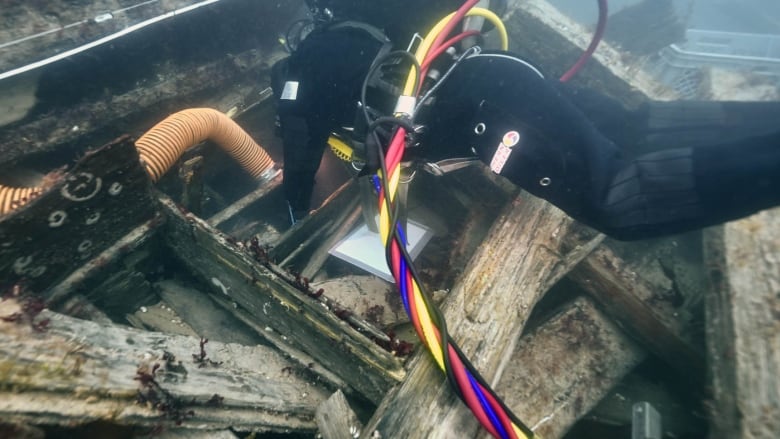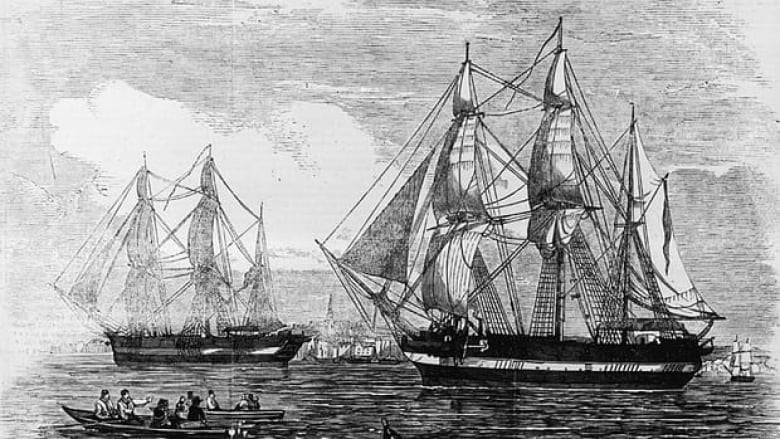'Hallowed space': Divers pull 275 artifacts from 2022 excavation of Franklin ship
'We came across a folio a leather book cover, beautifullyembossed with pages inside'

Eleven metres below the surface of the Northwest Passage, deep within the wreck of one of Capt. John Franklin's doomed ships,something caught the eye of diver Ryan Harris.
Harris was in the middle of the 2022 field season on the wreck ofHMS Erebus. The team had been hauling dozens of artifacts to thesurface elaborate table settings, a lieutenant's epaulets stillin their case, a lens from someone's eyeglasses.
But this, sitting within the steward's pantry, was somethingelse.
"It's probably the most remarkable find of the summer," saidHarris, one of the Parks Canada team of archaeologist divers whohave been excavating Franklin's two lost ships since they were foundunder the Arctic seas.
"We came across a folio a leather book cover, beautifullyembossed with pages inside. It actually has the feather quill penstill tucked inside the cover like a journal that you might write inand put on your bedside table before turning in."
Maybe it's just an inventory of stores or someone's laundry list. It was found in the pantry. Or maybe it's more.
"We're quite excited at the tantalizing possibility that thisartifact might have written materials inside," Harris said. "It's being analyzed in the lab now."

Erebus and HMS Terror set out from England in 1845. Commander SirJohn Franklin and his 129 men never returned.
More than 30 expeditions tried to find them. A few artifacts,graves and ghastly tales of cannibalism is all they uncovered.
But with a blend of Inuit oral history and systematic, high-techsurveys, Erebus was found in 2014, just off the northwest coast ofKing William Island in Nunavut and Terror two years later. Thediscoveries made headlines around the world.
56 dives in 11 days
Since then, Parks Canada has been working to understand what isdown there and what light it could shed on a story that has becomepart of Canadian lore.
Divers didn't visit Terror in 2022. That vessel, down twice asdeep as Erebus, is deemed more secure and the archaeologists wanted to excavate the more vulnerable wreck first.

After two seasons lost because of the COVID-19 pandemic, it was abusy summer.
Field seasons in the Arctic are brief. The divers andconservators had just 11 days moored over the site of the wreck with their tender barge and the RV David Thompson, Parks Canada's29-metre research ship.
But over that time the team squeezed in 56 dives. Each divelasted about two hours possible only because the divers usedsuits heated by warm water pumped from the surface.
Harris said the ship seems to have been left in good order. Doorsand drawers were closed, everything squared away.
A total of 275 artifacts were recovered. The steward's pantry wasa main focus of the summer and much of what was recovered from thereis tableware stoneware plates, platters and serving dishes.
Painstaking work
The divers also began excavating the officers' cabins. In the onethat would have been occupied by 2nd Lt. Henry Thomas Dundas leVesconte, whom Franklin charged with map-making, they found a greenbox that at first looked like a book.
"My partner and I realized that it's not a book at all," Harrissaid. "It's actually a set of drafting implements theprofessional tools of the trade for a ship's officer. It's quitepossible these are the tools used to map their way through theNorthwest Passage, which I think is fantastic."

Divers use a vacuum dredge to clear away much of the accumulatedsediment.
The work, however, remains slow, painstaking and delicate. Theleather folio was excavated bit by bit with a spoon.
On one dive, Harris was handling the dredge when he suddenlystopped.
"I started to see what looked like a piece of paper almostfluttering in the movements of the water. This is very, very
delicate."
That paper surfaced in a Ziploc bag and is now being analyzed.
There are years of work to do, Harris said. Divers have onlypoked their masks into a few square metres of a wreck 36 metreslong, nine metres wide and five metres deep.
'A remarkable thing to experience'
Much remains in the officers' cabins. The sailors' chests, whichheld their personal belongings, are still mysterious. Divers haven'teven entered the bottom deck. And then there's Terror.
"There's so much material in either of these ships," Harrissaid.

Retrieving it from the icy deeps is only part of the job. Theartifacts have to be conserved, studied and analyzed at Parks Canada's lab in Ottawa, where this summer's haul now sits.
Harris has dived to the wreck many times and acknowledges he getsfocused on the task at hand. Nothing, after all, will ever match hisfirst sight of Erebus.
"I couldn't see where the wreck was because the visibility waspoor," he recalled. "I had to pick a direction and go, and then Isaw the first plank lying on the sea floor.
"I followed it hand over hand until all of a sudden, out of thegloom, there it looms. It's towering overtop of you, the shadow ofthis enormous bulk of shipwreck lying proud on the sea floor."
But the thrill never entirely fades.
"You're taken with this feeling that you're in this hallowedspace. Not just in view of the history, but because here's where human beings were confronted with their own mortality. It's aremarkable thing to experience."












_(720p).jpg)


 OFFICIAL HD MUSIC VIDEO.jpg)
.jpg)



























































































